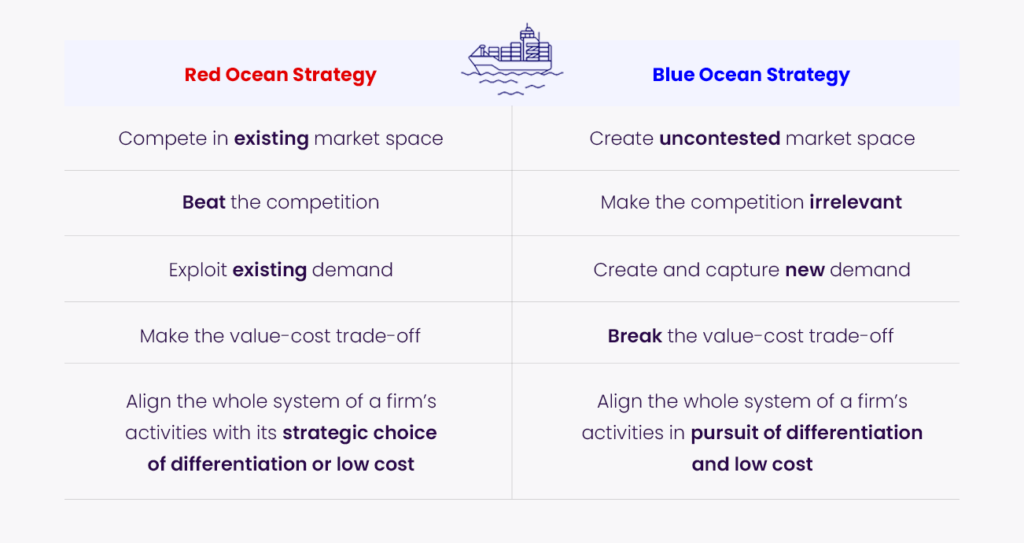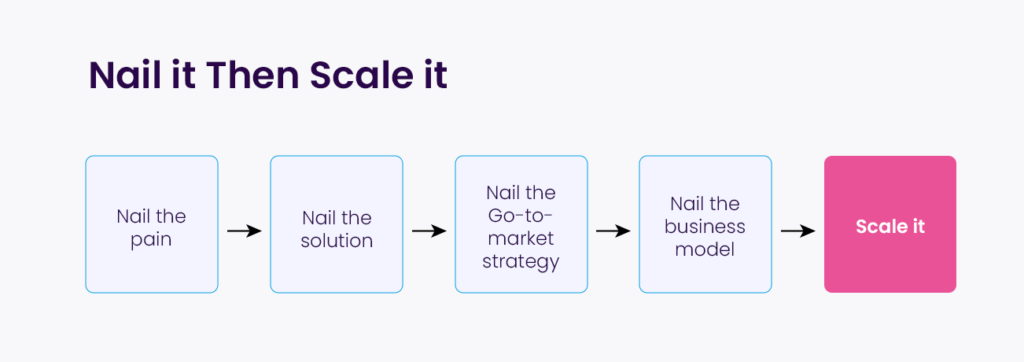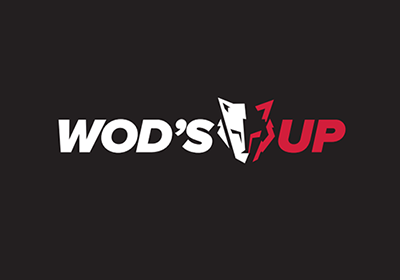The itCraft series: Product/Market Fit. Part 3: Fitting

Jakub Oleksy

Alexa Trachim

Here we are! The third episode of our product/market fit series. We are slowly approaching the finish line, but before we talk about case studies and real-life examples of well-fitted products and markets, we have to explain what this fitting actually means. Hopefully, you read our previous articles, and you already know the two crucial ingredients of this formula. Now, we will put them together to help you achieve your business goals and become the next industry leader.
Table of contents
1. How to fit product and market together?2. Disruptive technologies
3. The Blue Ocean Strategy
4. Nail it Then Scale it
5. Summary
Let’s talk about different methods of connecting your product and target market. It’s essential to pick one that is suitable for your needs and style of work. This way, you will achieve success. Remember to take your customers’ and stakeholders’ expectations into consideration.
How to fit product and market together?
When you find the product/market fit, it means that your company sells the product in large quantities to satisfied customers. Your business becomes recognizable, and its reputation is positively increasing. Market shares and advantages over competitors are also significant here. The biggest success though is when the name of your product starts to describe the whole category of products. This phenomenon is called “genericized trademark” and the example is Kleenex for all facial tissues in the US.
You can probably guess that defining the proper product/market fit is not a piece of cake. If it was, every brand would make tons of money and have many loving customers. As we all know, that’s not the case. That’s why there are several different ways to determine product/market fit. New companies and established enterprises that want to release fresh products use them to ensure their efforts will pay off. You can pick the one that corresponds with you the most or utilize them all if you need a more thorough insight.
Disruptive technologies
In today’s world, standard marketing practices are usually not enough. You have to be creative and look for opportunities everywhere. A proven strategy might be great if you just want to make some money and stay in the middle as a player in your niche. If you are going to conquer the market and leave your competition behind, think outside the box.
Disruptive technologies is a method that is particularly interesting because it focuses on neglected clients. While current market leaders focus on the mainstream group of customers that want to pay money for their product without a blink of an eye, smaller brands that are just entering the market can focus on other potential audiences that the big players overlook.
Here’s an example: you might want to build and sell high-end electronics, for example, smartphones. Instead of creating another expensive model with dozens of advanced features, you can make a more basic one that still offers good quality but costs much less. If you provide a product that stands out, you will not only gain customers from a group that couldn’t find anything for themselves before. You might also win over your competitors’ clients.
Some “disruptors”, as they are called, also create new markets and address their offer to people who don’t buy popular products at all. This is called disruptive innovation. Right now, every new product that transforms the market and becomes a dominating solution can be called disruptive. However, it doesn’t correspond with the original meaning of this term because novelties are not always dedicated to neglected customers.
How to discover the disruptive potential of your product?
You can take five steps to assess your product idea and find out if it can be disruptive. Of course, not every solution can be disruptive and not every brand should strive to do so. Still, if you have time and resources, you can give this idea a more profound thought. Maybe you will discover potential that you wouldn’t think of earlier.
Step one: Is your idea sustaining or disruptive?
Determining that is crucial to going further. Sustaining innovations basically mean that the existing products are improved. On the other hand, disruptive ones offer low-end products to clients that can’t or don’t want to buy widely known solutions. How to determine if your product represents one or another option?
Ask yourself some questions. If your product is an improved version of something already out there, it will be sustaining. Your idea’s future potential can also indicate how disruptive it can be. An interesting approach includes measuring your internal team’s moods towards the product. They might not feel entirely comfortable with the concept, and that’s a sign it can be a disruptive one.
Step two: What’s your innovation’s potential?
Now you have to find out if your disruptive product is worth pursuing. You might be tempted to ask your potential customers what they think, but it’s not always insightful enough, as these people are not tech experts. Thus, they can’t judge new ideas with a long-term perspective in mind. In that case, you should ask specialists from your own company. They will more likely share an opinion based on their experience and predictions for the upcoming years.
Think about your competitive advantage. Does your product have any drawbacks that can backfire in the future? Will it evolve with the market? Maybe you don’t even have to create content, but rather give people a platform to share theirs, like Instagram? Possibilities are countless, but you have to be 100% sure that your idea is viable.
Step three: What is your initial market?
We already talked about the market in our previous article, but you will need additional research in this case. Analyzing the general target audience will lead you nowhere, but the market segmentation tool can be pretty helpful. With it, you can identify overlooked customer groups or even create new ones.
Host a brainstorming session with your team to determine what values your disruptive product can offer to be appreciated by potential buyers. Early adopters are a group of customers you should pay attention to. These people love new products and are not afraid to try new things. Also, try to find clients who are currently not interested in mainstream solutions on the market.
Step four: Can you separate the project from your ordinary business?
If you have an idea for a groundbreaking product, it’s worth creating a new company for it. Of course, it can still be a part of your operations. However, separating your business from the new project will give you more space for experiments and not disturb your usual activities. Make sure your finances are in order because a new organization might not provide profit for some time.
As a business owner, you want your employees to work on daily tasks and not focus on a new, disruptive solution. Why? Because that could harm their productivity and pull them away from things they should take care of. Either hire a couple of specialists for the new company, so they can focus entirely on creating your new product, or work on it yourself. This way, your current company will be able to work efficiently as usual.
Step five: Can the spin-off company work independently?
When your product achieves success and starts making money, do not join the companies. Merges can create resource competition between two (or more) solutions you invested in. Also, you won’t have as much flexibility as if the brands stayed separated.
Each business should be self-sufficient and grow at its own pace. Of course, that requires workforce and effort. That’s why you need proper management. Your task is to find it and delegate work to make sure everything goes as planned.
The Blue Ocean Strategy
This method of fitting products into markets corresponds with the previous one, as its primary goal is seeking innovation and undiscovered market niches. Blue ocean companies don’t have to compete directly with other players because they create new demands instead of fulfilling the existing ones. Low cost and differentiation distinguish them from other businesses because they want to achieve both of those things.

They stand in opposition to red ocean companies that try to beat their competition within the existing market. Their products are adjusted to the demand that the customers express. Often, decision-making and planning in such companies are focused on the established boundaries and industry standards. This approach is quite limited. However, such businesses are needed. Not everyone can create a blue ocean. Stable profit, predictable future and lower cost of running are the advantages of the red ocean approach.
We came to a point where the blue ocean strategy can give new players a much better chance of succeeding. The competition in every possible industry is fierce, and that’s why new markets have to be discovered or created.
W. Chan Kim and Renée Mauborgne, the authors of a 2004 book called Blue Ocean Strategy, distinguished five steps that are required to incorporate this method:
- Finding a team with a blue ocean mindset
- Analyzing the current situation of the company
- Determining market limitations and hidden potentials
- Developing alternative offers and redefining industry boundaries
- Choosing the right strategy by rapid testing and releasing the product when they show positive results
If you feel like you don’t want to compete with other players anymore and your goal is to break the stagnation of your niche, the blue ocean strategy is for you. It’s great for visionaries that are not afraid to bet on unusual solutions.
Nail it Then Scale it
Another approach that promotes innovation. It’s a methodology that challenges traditional, risky entrepreneurship that is based on assumptions and not validation. The Nail it Then Scale it process is based on five steps, and each one of them forces the product owner to evaluate their ideas. Let’s take a closer look.

Each phase has its meaning and is crucial to delivering products that offer value to customers and profit for your company. Here’s what you have to do if you want to use it:
Step one: Nail the pain
Think about the customers you want to address. What problems do they need to solve? Write down all the hypothetical pains and then test them to find out if people really are searching for solutions. Sometimes, business owners create products that solve their own problems. Meanwhile, they should find out if there’s someone else who shares their pain. Building a product without validation of the pain is one of the most common mistakes.
Step two: Nail the solution
In this model, the product you create has to be tested several times. Virtual prototype evaluates the sales process. A physical prototype is used to check out the distribution and then communication. In the end, we have to test the final solution to make sure it works and fulfills customer needs. Releasing the product without proper validation is not permissible in this model and can result poorly.
Step three: Nail go-to-market strategy
This is the moment where we have to find out customers’ buying habits and market structure. Your goal here is not only to define your target audience but also to determine how and where you will sell the product. Conduct thorough research and learn the ways to promote your solution effectively.
Step four: Nail the business model
Take all the data that you collected until now and create an appropriate business model. Who are your crucial partners? Which channels will you use for sales? Analyze your cost structure and revenue sources. Also, identify your resources and the way you will measure the effects of your marketing activities. Write all these things down in a document and update it when your business evolves. This way, you will always be aware of changes that have to be done, new potential problems and challenges you need to conquer. You can use Business Model Canvas to visualize mentioned information.
Step five: Scale it
All the previous steps are preparations for future growth. You shouldn’t let your business scale too fast, as you might not be able to handle it. Better complete all the “nail it” points and see how your sales are going. It might be tempting to reach out for more money, but the project might quickly collapse without validation and everything prepared in detail. Having a solid foundation and taking baby steps is the best way to scale successfully.
To sum it up
We’re done with the third part of our product/market fit series. Now you know how to strategize your process and activities to achieve success. This article focused on innovative approaches and methodologies because we believe that the industries will constantly change in the upcoming years. Without visionary thinking, new companies won’t survive. These three models we described above have a lot in common, and their main goal is to help you meet the needs of your target customers, but also to achieve satisfying profit.
We are near the end of our series. Check out our previous articles to find out how to define a perfect product and determine an ideal market. In the upcoming episode, we will share some well-done product/market fit examples, analyze them, and give you conclusions you can use in your new business. And if you need support in building a solution that will conquer your industry, let us know. Our business consultants are here for you, and they offer excellent expertise and years of experience. Get in touch so we can discuss all the details!





